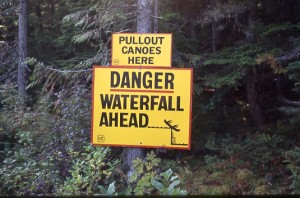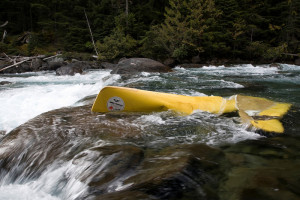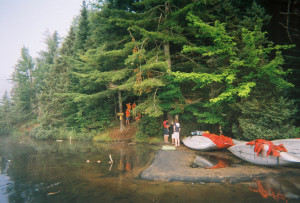Cliff Jacobson, in his book Canoeing Wild Rivers, 5th ed, 2015, lists the following as significant hazards when canoeing in the wilderness (pay attention future Northern Tier, Maine High Adventure, and other wilderness canoeists!):
- Over-reliance on maps and contour intervals (sometimes maps are inaccurate, and contour intervals larger than the hazard, requiring scouting of upcoming sections of rivers)
- Falls (prepare for their arrival, give them wide berth)
- Wind (wind can play havoc with direction and speed, not to mention creating dangerous waves)
- Dams (as with falls, prepare for their arrival, and give wide berth)
- Strainers (strainers may come and go – expect the unexpected)
- Canyons (the dangers of running a canyon are several, including the inability or difficulty in exiting the canyon if an incident occurs, and the difficulty in determining the severity of rapids in the canyon). See, this story. Note, also, the Guide to Safe Scouting prohibition against canoeing any river rated above Class III.
- Cold water temperature (cold water – the “silent killer”, even when wearing a PFD)
- Poor communication/lack of support or buddy canoe (absent assistance from a buddy canoe, canoeists may place themselves in a position of no return)
- Capsizing on open water (open water boating creates its own hazards, including the build up of dangerous waves due to wind, distance from shore, etc.)
- Lightning (being on water in a boat is its own hazard during a lightning storm)
- Not scouting rapids (not scouting rapids prior to running them prevents preparation, and also fails to identify newly-existing hazards)
- Failure to heed the advice of locals (the locals know the terrain/water better than anyone – seek and heed their advice)
- Poor planning/lack of experience (this may affect the type of gear used, the time allotted for the adventure, amount of preparation undertaken, etc.)
- Tides (in the event you are on a body of water subject to the effect of tides, this must be taken into account during route planning and time/distance planning)
- Patience (sometimes patience is required when taking into account bad weather, or other incidents which have an effect on the trip schedule – avoid rash decisions in the face of time pressures)
 Sadly, some of the above admonitions are borne out by this tragic Boundary Waters canoeing story. And, this story involving the dangers of dams in a canoe.
Sadly, some of the above admonitions are borne out by this tragic Boundary Waters canoeing story. And, this story involving the dangers of dams in a canoe.
A Scout crew inadvertently was swept over Basswood Falls in the Boundary Waters, resulting in destruction of two of their canoes, with two Scouts having to be rescued from the water beneath the falls.
Another group narrowly escaped tragedy, having one capsized teenager pinned in the cold water of Upper Basswood Falls (the same falls where the tragedy of the previous story occurred) for over six hours while his head was being held out of the water by another before the semi-conscious, severely hypothermic, teenager was rescued.
 And, in this story, a Boy Scout group rescued two swamped canoeists (father and young daughter) in the Boundary Waters, incapable of self-rescue, due to exposure to the cold water.
And, in this story, a Boy Scout group rescued two swamped canoeists (father and young daughter) in the Boundary Waters, incapable of self-rescue, due to exposure to the cold water.
Remember, the potential effects of any of the above can be enhanced when youth are involved, not to mention inexperienced, yet well-meaning, adult volunteers.
Of note, BSA and the American Canoe Association (ACA) in 2016 produced a new “moving water” canoeing/kayaking safety video titled “Reading the Rhythms of Rivers and Rapids”.
Units may request a free copy from the ACA (all units who canoe or kayak on rivers should do so!).
Finally, the author received the following comments from a scout leader whose crew spent time canoeing on the cold lakes and rivers of Maine in early summer 2018:
“My troop recently conducted a canoe tour on the Allagash Wilderness Waterway in Maine. Your webpage has a very useful article on the cold-water hazards. It guided me to research the risks we faced in paddling the lakes and river with water temperatures ranging from 55 to 65 degrees. The reference to the BSA Aquatics Supervision Manual carried the day for us, showing the need to use thermal protective gear. Fortunately, we did not have any accidental immersions in the colder lake waters. While on whitewater, we had several overturned canoes in the river in 64 degree water. The use of wetsuits was much more appreciated by those ending up in the water. Thanks for your effort to create and maintain your website. I look forward to learning more from your book.”

